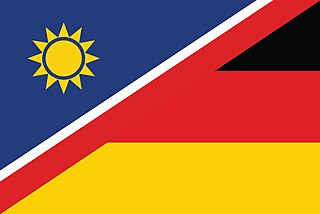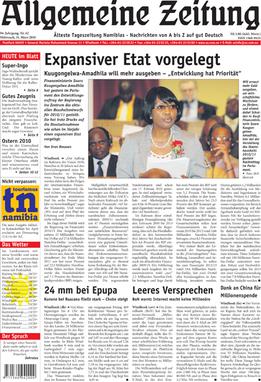
Namibia, officially the Republic of Namibia, is a country in Southern Africa. Its western border is the Atlantic Ocean. It shares land borders with Angola and Zambia to the north, Botswana to the east and South Africa to the east and south. Although it does not border Zimbabwe, less than 200 metres of the Botswanan right bank of the Zambezi River separates the two countries. Its capital and largest city is Windhoek.
The history of Namibia has passed through several distinct stages from being colonised in the late nineteenth century to Namibia's independence on 21 March 1990.

Windhoek is the capital and largest city of Namibia. It is located in central Namibia in the Khomas Highland plateau area, at around 1,700 m (5,600 ft) above sea level, almost exactly at the country's geographical centre. The population of Windhoek, which was 486,169 in 2023, is constantly growing due to a continued migration from other regions in Namibia.

Hage Gottfried Geingob was a Namibian politician who served as the third president of Namibia from 2015 until his death in February 2024. Geingob was the first Prime Minister of Namibia from 1990 to 2002, and served as prime minister again from 2012 to 2015. Between 2008 and 2012 Geingob served as Minister of Trade and Industry.In November 2014, Geingob was elected president of Namibia by an overwhelming margin. In November 2017, Geingob became the third president of the ruling SWAPO Party after winning by a large margin at the party's sixth Congress. He served as the party's president until his death. In August 2018, Geingob began a one-year term as chairperson of the Southern African Development Community.

Hosea Kutako International Airport is the main international airport of Namibia, serving the capital city Windhoek. Located well east of the city, 45 km (28 mi), it is Namibia's largest airport with international connections. From its founding in 1965 to the independence of Namibia in 1990, it was named J.G. Strijdom Airport. In 1990 the airport was renamed, in honor of Namibian national hero Hosea Kutako.

German Namibians are a community of people descended from ethnic German colonists who settled in present-day Namibia. In 1883, the German trader Adolf Lüderitz bought what would become the southern coast of Namibia from Josef Frederiks II, a chief of the local Oorlam people, and founded the city of Lüderitz. The German government, eager to gain overseas possessions, annexed the territory soon after, proclaiming it German South West Africa. Small numbers of Germans subsequently immigrated there, many coming as soldiers, traders, diamond miners, or colonial officials. In 1915, during the course of World War I, Germany lost its colonial possessions, including South West Africa ; after the war, the former German colony was administered as a South African mandate. The German settlers were allowed to remain and, until independence in 1990, German remained an official language of the territory alongside Afrikaans and English.

The Diocese of Namibia is part of the Anglican Church of Southern Africa, which is itself part of the Anglican Communion. The diocese, which covers the whole country of Namibia, was originally known as the Diocese of Damaraland. Most of the Anglicans in Namibia live in Ovamboland in the north of the country and speak the Oshikwanyama language.

The Namibia University of Science and Technology (NUST), formerly known as Polytechnic of Namibia, is a public university located in the city of Windhoek, Namibia. NUST was headed by the founding vice-chancellor Tjama Tjivikua until March 2019. After two acting appointments, Erold Naomab was appointed vice-chancellor in January 2021. The largely ceremonial role of chancellor of the university is held by Peter Katjavivi.
The National Library of Namibia (NLN) is the legal deposit and copyright library for Namibia. The library is situated in Windhoek. NLN belongs to the National Library and Archives service of the Namibian government, in the Ministry of Education, Arts and Culture. The National Library is guided by a Policy Framework for Libraries and Allied Information Agencies for Namibia of 1997 and the Namibia Library and Information Service Act 4 of 2000.

Heroes' Acre is an official war memorial of the Republic of Namibia. Built into the uninhabited hills 10 kilometres (6 mi) south of the city centre of Windhoek, Heroes' Acre opened on 26 August 2002. It was created to "foster a spirit of patriotism and nationalism, and to pass [this] to the future generations of Namibia".

The Allgemeine Zeitung founded in 1916, is the oldest daily newspaper in Namibia and the only German-language daily in Africa to survive World War I.
Gottlieb Wilhelm Eduard Redecker was a German civil engineer and architect in South West Africa. He was responsible for a number of important buildings which still stand today in Namibia, particularly in Windhoek, including the national assembly building, the Tintenpalast.

German South West Africa was a colony of the German Empire from 1884 until 1915, though Germany did not officially recognise its loss of this territory until the 1919 Treaty of Versailles.

The Alte Feste is a fortress and museum in downtown Windhoek, the capital of Namibia. It is situated in Robert Mugabe Avenue, next to the Independence Memorial Museum.

The rail service in Namibia is provided by TransNamib. The Namibian rail network consists of 2,687 km of tracks (2017).

Namibia is a multilingual country in which German is recognised as a national language. While English has been the sole official language of the country since 1990, in many areas of the country, German enjoys official status at a community level. A national variety of German is also known as Namdeutsch.
The following is a timeline of the history of the city of Windhoek, Namibia.

Squatting in Namibia is the occupation of unused land or derelict buildings without the permission of the owner. European settlers arrived in the nineteenth century and acquired land, leaving only 38 per cent of land in indigenous hands by 1902. This led to squatting and the Herero Wars, which ended with the Herero and Namaqua genocide. After Namibian independence in 1990, squatting increased as people migrated to the cities and land reform became a goal for those who had participated in the liberation struggle. By 2020, 401,748 people were living in 113 informal settlements across the country. Squatting continues to be regulated by the Squatters Proclamation of 1985; a challenge to this law was dismissed by the High Court in 2023.

The National Museum of Namibia is a historical and zoological museum in Windhoek, the capital of Namibia. It is governed by the Ministry of Education, Arts and Culture of the Namibian government.
Rosemary Jane Tuauana Katjavivi was an English-born Namibian author, publisher and editor.














